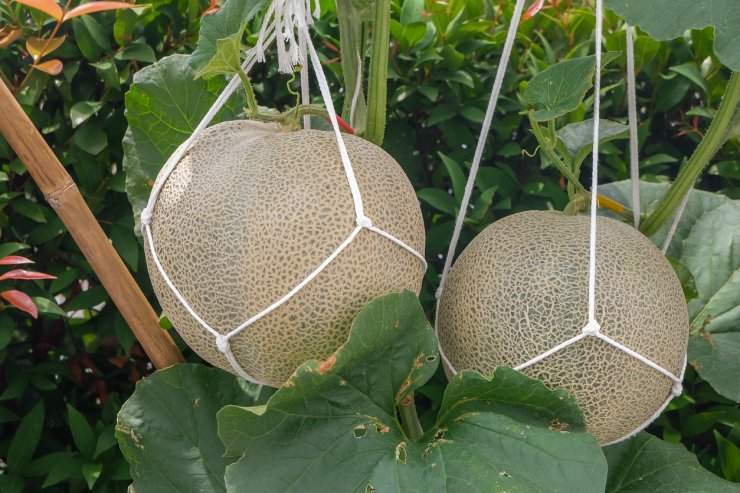
Cantaloupes being supported by a melon net.
What’s that? Growing cantaloupe vertically? I get it. Vertical gardening is a super way to get more out of your space, and it’s a fantastic idea for fruits and vegetables like peas or beans. Cantaloupe, though? Seems like they would be too big and heavy to grow vertically. Spoiler alert: Growing cantaloupe vertically is very much doable.
It’s true. A cantaloupe can get pretty heavy, so there’s a little more to it than just setting up your trellis and moving on. But you don’t have to miss out on growing this sweet treat just because you don’t have acres of pastoral land.
Explore the easiest fruit to grow at home—indoors or out! Read our FREEBIE 15 Easiest Fruits to Grow at Home, right now!
Growing cantaloupe in any garden – even a container garden
First let’s talk about growing cantaloupe. They do take a little work, and you’ll need to be sure you have plenty of pollinators in your garden to carry pollen between the male and female flowers. They can also be susceptible to pests and disease. So why wouldn’t you just buy them at the store?
Like tomatoes, there’s just no competition between a store-bought cantaloupe and one you grow in your garden. It’s not even close. Heirloom varieties like the “Hearts of Gold,” or a hybrid like the small “Sugar Cube,” are as sweet and juicy as could be. And incidentally, the “Sugar Cube” is fairly disease resistant.
As for growing cantaloupe, they need plenty of warmth and sunshine, and they’re slow-growing, so unless you live in a southern climate, you’ll need to start the seeds indoors about four to six weeks before your last spring frost. Once your soil hits 60 degrees or above, you can move your plants outdoors. Pick a sunny spot and space your plants about 12 inches apart. What else?
- Make sure you have healthy, well-draining soil.
- Cantaloupes need plenty of water, but too much and their sugars won’t develop. It’s best to water them deeply, but infrequently.
- Water them less frequently as the fruit matures, cutting back as much as you can in the last week before they ripen.
- Keep the area free of weeds, as cantaloupe plants have shallow roots.
- Do NOT prune the leaves and shoots; these help sweeten the fruit.
- Do, however, limit the number of cantaloupe growing on any one vine. The more fruits there are, the more the sugars get spread out.
Growing cantaloupe plants on a trellis
Once you’ve got the how-to’s of growing cantaloupe, the vertical part is easy. The vines can grow several feet, and the fruits can be heavy, so be sure you use a sturdy, tall trellis. A fence can work well, as can an archway. As the vines grow, simply tie them loosely to your trellis. Once they’re trained, they should continue to grow around the supports without your intervention.
Since most melons typically grow on the ground, when the fruits start growing, they’ll need a little extra support in the form of hammocks. Old nylons or t-shirts work well for this, or you can buy specially designed hammocks to support the fruit.
When the rind turns tan or yellow, it’s harvest time. You may also notice a crack where the fruit and stem meet. The cantaloupe should detach easily from the vine. Then comes the part you’ve been waiting all summer for – cutting into and enjoying the sweet fruit of your labor.
What is your experience with growing fruits like cantaloupes in your garden? I’d love to read your stories in the comment section.
Explore the easiest fruit to grow at home—indoors or out! Read our FREEBIE 15 Easiest Fruits to Grow at Home, right now!





I did the last year but, did not use a hammock. The plant naturally supported itself no problem. I have also tried it with pumpkins. Depending on the size of the pumpkin, some did need a hammock.
Is end of June-July too late to plant cantaloupe seeds in central-north central Alabama?
My cantaloupe always rot on the ground right before harvest
Trying vertical cantaloupe this year. We live in New England, so started seeds indoors and planted the end of May.. The plants have a lot of blossoms on them and I was wondering if we should remove some before they all start to fruit.
I’ve tried growing melons this year vertically they were absolutely doing wonderful until I don’t know what got at them raccoon it’s groundhogs something just as they were ripening they ate them right down to the rind any suggestions
I sure feel your PAIN! If I find the magic solution, I’ll let everyone know! Tm.
I would cut them just before they are ripened and ripen in a garden window.
I’ve grown melons in raised beds with wire mesh frames (sides & roof) to spread, and mesh veggie bags (“bra bags”) to support their weight. Biggest problem has been powdery mildew that starts on oldest leaves near roots (that are typically well shaded) and spre from there.
Seems that removing those oldest as they start to yellow (reducing their value for the vines & fruit) would allow more sunshine & airflow to retard the mildew.
I love this tip, I’m going to try it this year and see if it helps mine!
Pandemic and food prices stopped this senior citizen from purchasing vegetables and fresh fruit. Instead of getting mad I got busy. My handicapped hands didn’t stop me, but it took a long time to get much done. I read this and said, “vertical…why not.” I didn’t have the money to get those fancy looking arbors, so an old six foot ladder should work. After reading this I’m excited to see what’s going to happen with my package of cantaloupe seeds. I’m using raised beds, so this should be easy to do. Home grown is so much better anyway, so it looks like this will be a new norm for us all.
I’d love to know how it turns out! A ladder should work just fine!